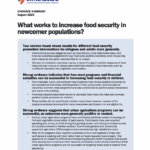International migration is contributing to changes in the sociocultural and the economic landscapes of many cities in the world. As part of the changes in cities, we are witnessing an increased use of community gardens as spaces for wellbeing restoration, for social connection, and for addressing the challenge of food insecurity, particularly cultural food insecurity. Cultural food security is one major under-recognized issue, yet is pivotal to address given its role in positively supporting immigrants’ settlement and health. However, there is lack of comprehensive evidence of how neighborhoods are changing to accommodate these initiatives and meet the cultural food needs of diverse communities. Our scoping review explored evidence from existing literature on how neighborhoods are changing to accommodate community gardens (CG) as a novel means to address cultural food insecurity among immigrant communities and support place-making and resettlement. Our literature search identified several areas of transformations including the different kinds of community gardens that have emerged, the associated physical, social, cultural, environmental, economic, and policy changes that have been reported in other countries in the Global North. The review also identified multifold benefits of CG in this regard, including benefits to health and wellbeing – the physical (i.e. nutrition and physical activity), mental (e.g., a place for healing for immigrants fleeing war-torn countries, domestic violence, trauma; fostering a connection to the land in new environments via place-making), and social (e.g., fostering community connections and cultural knowledge exchange). Despite the known benefits of community gardens to immigrants’ health and wellbeing, there remains a lack of comprehensive evidence in Canada on how neighborhoods are changing to accommodate these initiatives and meet the cultural food needs of diverse communities. Such studies will serve as sources of evidence for novel ideas to address the cultural food needs and food insecurity of immigrant communities, which is becoming a growing public health concern.
A Systematic Review on the Impact of Trauma-Informed Education Programs on Academic and Academic-Related Functioning for Students Who Have Experienced Childhood Adversity
The purpose of this study was to conduct a systematic review of the existing literature regarding trauma-informed education programs and their impact on academic and academic-related outcomes. The articles included for review (n=15) contained data on trauma-informed education programs implemented in preschool, primary/elementary, and high school settings. Academic and academic-related outcomes reported included attendance, disciplinary…

